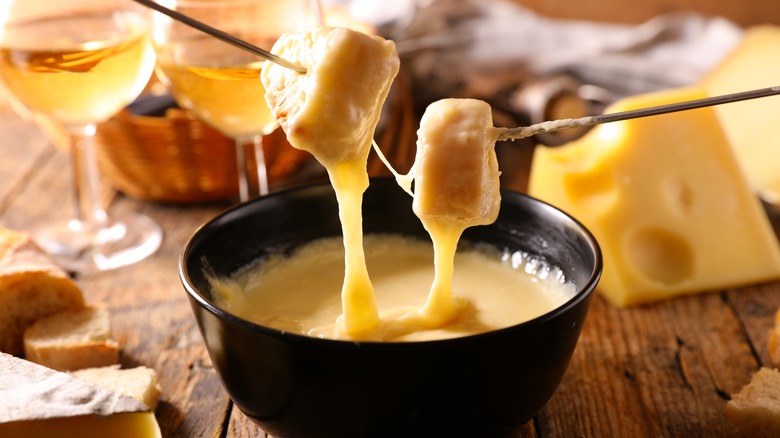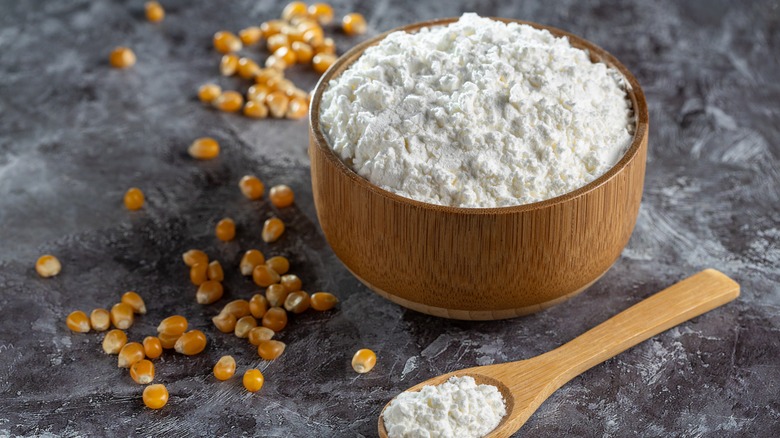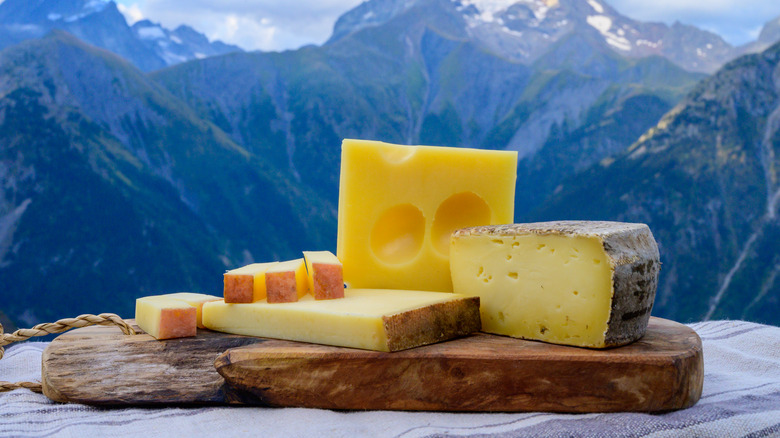The Pantry Ingredients You Need For Foolproof Fondue
For cheese lovers, there's no greater celebration of the dairy favorite than a pot of cheese fondue. It is essentially a vessel of hot, melted cheese into which you dip a variety of bite-sized nibbles like bread, veggies, and pickles. It's considered a traditional winter dish in Switzerland, but making it at home involves more than just melting some cheese in a pot; if you try that, you're likely to end up with a solid glob of cheese floating in oil and water instead of a cohesive, creamy concoction. To achieve and maintain the correct, melty consistency in fondue, you need to add a stabilizer like cornstarch to the mix.
Some traditional Swiss fondue recipes don't use cornstarch or any stabilizers at all. However, if the proportions of the ingredients are wrong, the temperature is off, or your stirring skills aren't up to par, it's very easy for homemade fondue to break and become difficult to salvage. Cornstarch, potato starch, or a bit of sodium citrate (a form of citric acid) helps to emulsify the cheese and wine, ultimately creating a very creamy, melty, and thick fondue that won't separate as it sits.
How stabilizers help create perfect fondue
Traditional Swiss fondue is made by heating some white wine in a pot and then slowly adding and stirring in shredded cheese until a melted mixture is formed. Of course, other flavorings are involved, but these two ingredients create the base of the dish. Anytime you are trying to combine these two elements, adding a stabilizer helps (think of vinaigrette: Mustard acts as a stabilizer, and helps the oil and water emulsify).
This is exactly what cornstarch, potato starch, or sodium citrate does in a fondue; it helps the water from the wine and the oils from the cheese mix together. White wine is naturally high in tartaric acid, which adheres to the oil in cheese when it's mixed correctly. This is how fondue recipes that don't use stabilizers can be successful, but again, precision is required, making cohesiveness harder to achieve.
To ensure your cornstarch or similar stabilizer is incorporated evenly into your fondue, sprinkle it over your shredded cheese, and gently mix to coat. As you add the cheese to the wine, the cornstarch is also gradually added.
More tips for a successful fondue
For sensational fondue (and who wants anything less?), the types of cheese you use definitely matter. Fondue typically consists of a mix of at least two varieties of Alpine cheeses due to the dish's Swiss origins, and to achieve that signature creamy consistency, the cheeses should be buttery and melt well. Classic examples include Gruyère mixed with Emmentaler, but you could also use fontina, Gouda, Comté, and raclette.
The wine you select is equally important due to the aforementioned amount of tartaric acid, which helps the mixture emulsify. White wines that are higher in acid are best, like sauvignon blanc or pinot grigio, but if you prefer not to include any alcohol, you can use sparkling cider or chicken or vegetable broth. In this case, you won't have the help of the tartaric acid, so you'll definitely want to incorporate cornstarch or something similar.
Finally, remember to take things slowly when it comes to incorporating your cheese. Work over low heat, adding the cheese a bit at a time and allowing the additions to fully melt before adding more. You'll also want to stir the fondue constantly to decrease the chances of the mixture breaking and separating. Yes, it's a fickle dish, but one that is well worth the time, effort, and ingredients you put into it.



